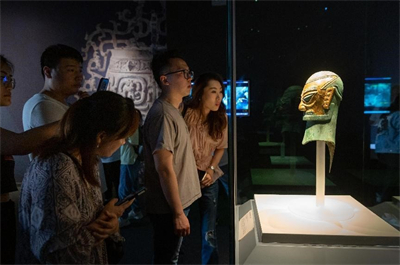Cultural digitalization makes progress at Sanxingdui Ruins site
The Sanxingdui Ruins site in Guanghan, southwest China's Sichuan province, is dubbed as one of the world's greatest archaeological findings of the 20th century. Every new excavation at the site would trigger an archaeology craze across China. The Sanxingdui Museum has thus become the hottest museum in Sichuan province.
Earlier this year, new findings were once again reported at the Sanxingdui Ruins site. A bronze kneeling statue holding a Zun-vessel over head unearthed at the No.3 sacrificial pit and a bronze mythical beast found at the No.8 sacrificial pit were virtually combined under the assistance from 3D scanning technology.

Photo shows a Sanxingdui-themed digital animation. [Photo courtesy of the Sanxingdui Museum]
The two cultural relics, buried in two different pits, finally "reunited" with each other after more than 3,000 years and now constitute a larger bronze artifact, which is unprecedented even in the world.
The successful virtual combination of the two cultural relics was a result of the application of digital 3D model technology. It marked another innovation in China's technical approaches to cultural relics conservation and studies, as well as a typical example of the cultural digitalization development of the Sanxingdui.
"We employ digital technologies when archaeological excavation starts," said Zhu Yarong, deputy curator of the Sanxingdui Museum, adding that the museum aims to vitalize cultural relics through digital technologies and creative protection methods.
According to her, the inter-discipline cooperation during the archaeological excavations at the Sanxingdui Ruins site represents a new model of future archaeological development. The integration of a new generation of digital technologies and archaeology is important to archeological development, she added.
A tourist surnamed Chen from Xi'an, northwest China's Shaanxi province, recently visited the Sanxingdui Museum and watched a mixed reality (MR) movie about the Sanxingdui culture, the first of its kind launched by the museum.
With a pair of MR goggles, Chen saw ancient citizens of the kingdom of Shu praying around a sacred tree and a three-legged crow flying in the sky. Besides, in the earphones she wore, there was also a virtual tour guide explaining the history of cultural relics at the Sanxingdui Ruins site.
This brand new model of museum visiting, which enables visitors to watch cultural relics in a movie, can better present the splendid Sanxingdui culture to visitors.
It's not rare in China to present cultural relics in 3D pictures with augmented reality and MR technologies, said Zhang Song, an employee with the Sanxingdui Museum. What's different at the Sanxingdui Museum is that virtual scenarios are mixed with reality so that visitors can not only see 3D pictures of cultural relics, but also have immersive experiences in a world of mixed reality, Zhang explained.

A bronze sculpture of human head with gold mask unearthed at the Sanxingdui Ruins site is exhibited at the Anhui Museum in east China's Anhui province, April 20, 2023. [People's Daily Online/Li Pengfei]
"Apart from archaeological excavation and conservation, it's also important to make the value of cultural relics known to all through technologies," Zhang told People's Daily.
Since 2016, the Sanxingdui Museum has implemented three projects of digital cultural relics conservation, during which it collected high-precision data of most of its cultural relics and set up a management platform of digital resources. So far, these achievements have been widely applied by the museum in display, cultural relics conservation, tour guide services, cultural communication and the development of cultural products.
Every cultural relic at the Sanxingdui Ruins site has a QR code that records its identity and whole life cycle from its excavation to repairing, which lays a data foundation for future utilization and development of relevant cultural products, Zhang said.
The possibility of combining fragments of cultural relics is estimated based on their colors, textures and cross sections after the fragments receive 3D scans, which significantly improves work efficiency, Zhang noted.
Digitalization is an important way to vitalize cultural resources. Earlier this year, Sichuan province issued an action plan on promoting cultural digitalization, which centered on seven aspects such as connecting the province to a national database of Chinese culture, building cultural digitalization infrastructure and building a cultural data service platform, and listed 22 major tasks including utilizing the results of cultural resource censuses, establishing a provincial data system and setting up an interaction platform of cultural data.
An expert told People's Daily that the efforts made by the Sanxingdui Museum to advance cultural digitalization not only demonstrated the strong impetus of Sichuan province for cultural digitalization, but also has made new business forms that combine culture and technology a key driver of growth in the culture industry.
Thanks to the integration of virtual reality, digital animation, online cultural, entertainment and tourism services, as well as cultural data processing and storage services, the market of Sichuan's digital cultural industry represented by the Sanxingdui Ruins site will keep growing in the future.
























